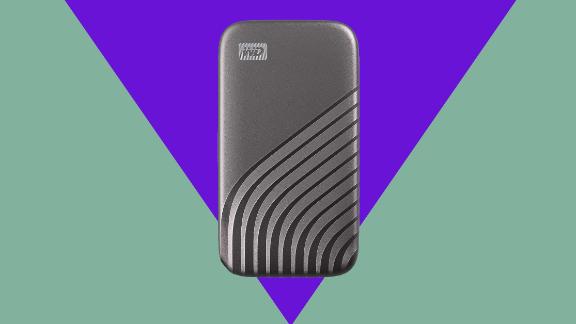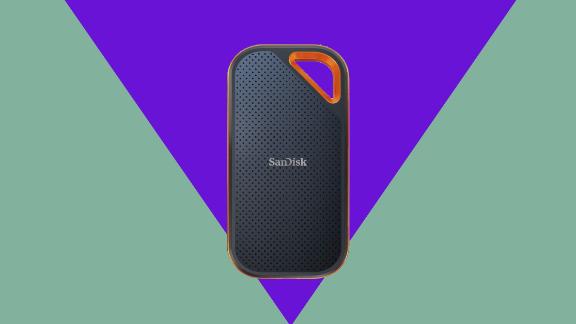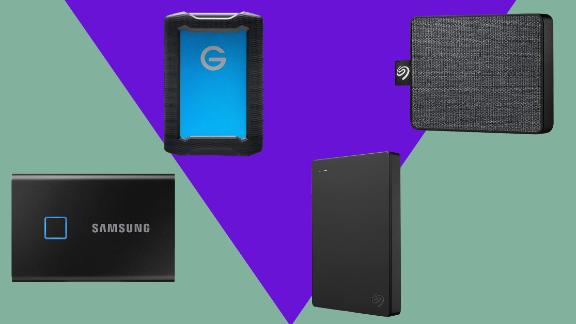
(CNN) —
As anyone who’s experienced a hard drive failure can tell you, stuff goes wrong and computers aren’t perfect. Which leads us to an eternal truth: Backing up your data is a must. And the best way to do so is with an external drive. Not only do they provide a tangible feel to backups, but they offer additional security and are often cheaper in the long run when compared to cloud services
When it comes to picking an external hard drive, though, there are options on top of options. Simple or stylish? Rugged or exposed? USB-A or USB-C? How much space do I need? How fast can it handle transfers?
To save you from falling down a rabbit hole, we chose seven top-of-the-line external drives to test and spent several weeks backing up data, running apps, conducting photo edits and video exports, and running read/write speed tests. When testing was complete, two external drives made us forget the cloud was ever created:
Starting at $89.99 (down from $119.99) for 512GB of storage, the WD My Passport solid-state drive is not the cheapest external drive on the market. But that somewhat lofty price brings big returns. Files transfer quickly: we were able to back up Word documents in just a few seconds, full photo albums in less than 20 seconds, and even large video files in under a minute. Those are speeds rivaling many devices’ onboard drives. My Passport has enough space to store all your files — packing close to 100,000 photo files, or in our case, two backups of our entire library. All that in a stylish yet rugged package.
At the higher end of the spectrum is the SanDisk Extreme Pro Portable SSD ($229.99), which was way out in front of the testing pool in terms of read and write speeds. Backup and open times were half that of our overall pick, as we were able to copy a modest 4K video file in just 12 seconds and 15 RAW images in 10 seconds, and opening a Final Cut Pro file with 4K video took just about 10 seconds. The 512GB version has enough storage to hold more than 128,000 12-megapixel photos or 1,000 minutes of 4K content. The durable build (with protection from drops of 6.5 feet) is perfect for on-the-go use. It may come at a premium, but for those searching for a top-of-the-line hard drive, the SanDisk will not disappoint.

Half the battle with getting in the habit of backing up your computer is plugging in the drive and actually doing the task. To that end, we think you’ll be more inclined to keep a drive with a slim build in a fun color out and accessible, rather than stuffed in a drawer and forgotten. The WD My Passport SSD is easily portable and fits in front or back jeans pockets or even a shirt pocket. You can also easily tuck it into a sleeve holding your laptop.
Though a compact beauty, it still handles drops of up to 6.5 feet, as stated by the manufacturer. In our testing, we dropped it on carpet, wood flooring, fake wood flooring, tile and concrete and noted only faint scratches on the outer shell without any damage to the actual function of the drive.
While the drive did at times peak at the manufacturer’s claimed 1050Mbps for read times and 1000Mbps for write times, speeds of 700Mbps in either direction were more typical. To put that in real terms, we were able to move a 4.5GB HD video file in about 15 seconds and a 6.5GB 4K video in about 30 seconds. Those are speeds you’d normally get on your internal drive. Backup times on Mac and PC were commendable, taking about an hour for a full backup of a 128GB drive via Time Machine. The SSD will give off some heat, and the My Passport SSD does feel noticeably warm during long backup sessions.
On the 1TB model, we were able to fit more than 250,000 photos onto the drive, more than four times the contents of our nearly-55,000-photo library; on a 512GB model we could hold two backups of our library. A rule of thumb: You want to choose an external drive that’s at least twice the size of the laptop you want to back up. So if you have 256GB internal storage, getting a 512GB drive is ideal, and 512GB internally means a 1TB is the best option.
Not only can you store photos, videos and music libraries on this drive, but real-time changes are pretty seamless. In our testing, we opened a photo off the My Passport SSD in Photoshop, made our edits and saved it back to the drive without issue. Its handling of JPEGs was on par with a Mac’s performance, but RAW and larger file formats caused a bit of a slowdown.
Those files are well protected on the My Passport, as you can password-protect all your data behind 256-bit AES encryption, though that was a standard feature of all the drives we tested.
The drive features a modern port — a USB-C — for faster transfer speeds, a welcome feature, as most laptops now opt for this port. There’s also an included USB-C to USB-C cable in the box, along with a USB-C to USB-A adapter. This way, it still works with older laptops that still feature the classic USB port. The My Passport SSD is plug and play with a Mac or a PC out of the box. With a Mac, you use it with Time Machine, Apple’s built-in backup program, or opt to use it as a big drive and just drag files to it. For a PC, you can utilize the preloaded simple backup software, which makes it easy to start backing up your data.
From our testing, the My Passport SSD is the best hard drive for most people and should set you up for many years of backing up files with a fast experience, quality build and space to fit every last shred of data.

If you’re someone who routinely works with large files — 4K or 8K video files, RAW images and large image libraries — and you’re willing to pay more for the quickest experience during everyday backups, then the SanDisk Extreme Pro Portable SSD is the external drive for you.
In terms of speeds, Sandisk notes that the Extreme Pro SSD can hit 2,000Mbps on read and write. That trumps nearly every other drive we tested. But what does this mean in everyday use? You can render and save a 6.5GB 4K video file to the Extreme Pro SSD in about 12 seconds. The My Passport, by comparison, took closer to 35 seconds to complete this same transfer. We were also able to do a rapid export of 15 RAW images from Lightroom in about 10 seconds; My Passport accomplished this in about a minute.
Backups from a MacBook Pro with 512GB internal storage to the Extreme Pro SSD happened quickly, with daily updates of around 2GB to 5GB taking just under a minute. This is, of course, after the Mac had indexed with Time Machine. We also tested speeds with a Lenovo ThinkPad Carbon X1 and a Surface Laptop 3 and found similar time frames.
The variant of the Extreme Pro SSD you choose will determine how much storage space you’ll get. Generally speaking, the 512GB drive can hold more than 128,000 12-megapixel photos or 1,000 minutes of 4K content. Scaling up to the 1TB gives you room for more than 170,000 photos and the 2TB can hold more than 510,000 photos.
The Extreme Pro SSD boasts an IP55 rating for water and dust resistance, so it’ll hold up against water sprayed from any direction. It’s also protected from drops up to 6.5 feet, which proved to be true during our drop tests. That’s thanks to the design, which is silicone on the bottom, an aluminum frame and a strong top case made from ABS. Internally, there is an absorption layer for shock resistance as well.
You can expect this drive to get warm, even more so than the My Passport SSD, something that was most noticeable in our testing during big data transfers and constant use.
SanDisk opted for a USB-C 3.2 port that supports the latest standards and allows for maximum throughput from the device to drive. And since it’s USB-C, this doesn’t just work with laptops and desktops, but you can plug it into a tablet with USB-C like the iPad Pro or Galaxy Tab S7.
With its huge space for countless files and lightning transfer times, the Extreme Pro Portable SSD justifies its rather steep price point. It’s also designed to be a workhorse and, thanks to its durability, to be out in the field — all the hallmarks of an external drive made for creatives.
With our testing of external drives, we looked at four core categories: performance, design, ports and warranty. As you may have guessed, a lot of our testing was both quantitative and qualitative with a tremendous number of speed tests conducted.
Specifically under the performance category, we performed benchmarks with industry standards like CrystalDiskMark, Black Magic Disk Speed Test and Amorphous Disk Mark — with close attention paid to copying, writing, reading, transferring data, full backups and everyday use.
All of the drives were tested with a number of devices running macOS, Windows, iOS, iPadOS and Android to ensure far-reaching compatibility. With the design category, we looked at the overall build and protection of internal components.
Ports were quite important, as they go hand in hand with the speeds that an external drive can produce and deliver. If a drive opted for a USB-A or USB-C port, we looked to see if an adapter was included at no cost as well. Lastly, we paid close attention to the warranties that were packaged with the drives.
- Performance had a maximum of 70 points: Benchmarks (10), Speeds (10), Copying (10), Writing (10), Transferring Data (10), Full Backup (10), and Compatibility with Android, Windows, macOS, Chrome, iOS and iPadOS (10).
- Design had a maximum of 30 points: Build quality (10), Durability (10) and Portability (10).
- Ports had a maximum of 15 points: Ports (10) and Cables (5).
- Warranty had a maximum of 5 points: Length and terms of warranty (5).

WD My Passport (Starting at $50, originally $59.99; amazon.com)
Don’t get us wrong: You can get a very large amount of storage for a relatively affordable price with the standard WD My Passport. Just know that with it, you’re getting a standard hard drive inside that features both moving parts and slower speeds. In our tests, it wasn’t the fastest but did provide a viable solution for backups. It’s an option if you’re absolutely weighing the amount of storage for the least money, but we think you’re better off with the SSD variant.
SanDisk Extreme Portable SSD (Starting at $94.99, originally $139.99; amazon.com)
This drive from SanDisk came up just short of the Extreme Pro Portable SSD, which was our top pick for creatives. Though it offers nearly the same speeds as our top pick, it has a slightly smaller build that lacks some core design elements like the aluminum frame. If you really like the Sandisk name or the black and red color scheme, this could deserve a second look, but for everyone else you’re better off with the Portable Pro or My Passport.
Samsung T5 SSD (Starting at $139.99, normally $249.99; amazon.com)
Make no mistake: We like the stack-of-credit-cards design of the Samsung T5 and the aluminum design. When it comes down to it, though, it had slower speeds, at around 540Mbps, and a higher price of $250 for just 1TB. At those speeds, it was a bit slower than both of our top picks, but also not as slow as a standard HDD (hard disc drive) solution.

Samsung T7 Touch SSD (Starting at $107.26, originally $129.99; amazon.com)
If you want security you can see, Samsung’s newer T7 has a fingerprint sensor locking and unlocking the drive right on the front. Like the T5, it keeps the compact size (akin to a stack of credit cards) and wraps it in aluminum. You’re limited to just black or silver in terms of color, though. It does hit read and write speeds right around 1,000Mbps as well, which is on par with our overall pick. Ultimately, though, the T7 Touch SSD is more expensive than the My Passport SSD, and not everyone needs a fingerprint sensor on an external drive.
G-Technology ArmorATD (Starting at $74.99, originally $79.99; amazon.com)
If we had written this guide just a few years back, this ArmorATD drive from G-Technology likely would have been a top pick. It has an ultra-rugged design with a rubber shell around an anodized aluminum build. All of this to protect the 2.5-inch hard disc drive inside that stores your data. It’s available in 1TB, 2TB, 4TB and 5TB sizes and features a USB-C port. But speeds for transferring or accessing data are slower at under 150Mbps. When you factor that into the equation, this just doesn’t make sense for the masses. If you don’t mind a standard drive, maybe plugged into a desktop and not on the go with you, this is an excellent solution for daily backups.
Seagate Basic (Starting at $47.99; amazon.com)
Similarly to the G-Tech ArmorATD and My Passport drive, the Seagate Basic is a simple external hard drive that is super affordable. But it’s a slower transfer thanks to a traditional HDD inside. It’s also paired with just a one-year warranty, and transfers took quite a bit longer, upward of a few minutes with our 4K file test on this drive.
Seagate One Touch SSD (Starting at $74.99, originally $79.99; amazon.com)
Seagate’s SSD option features a slim design that’s in a flat rectangle build. Interestingly enough, it has a textile design on the front that is unlike any other drive that we tested. Inside there is a fast SSD, but it’s not as fast as our top picks, with read and write speeds of around 400Mbps. That means data transfers and backups took about twice as long on the One Touch SSD in comparison to the My Passport SSD.
Read more from CNN Underscored’s hands-on testing:
Read the Original Article HERE
The post Best external hard drives 2020 first appeared on MetNews.
from MetNews https://metnews.pw/best-external-hard-drives-2020/
No comments:
Post a Comment